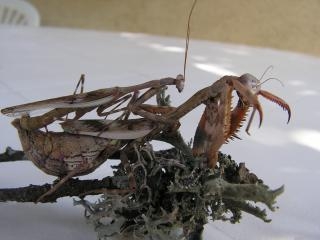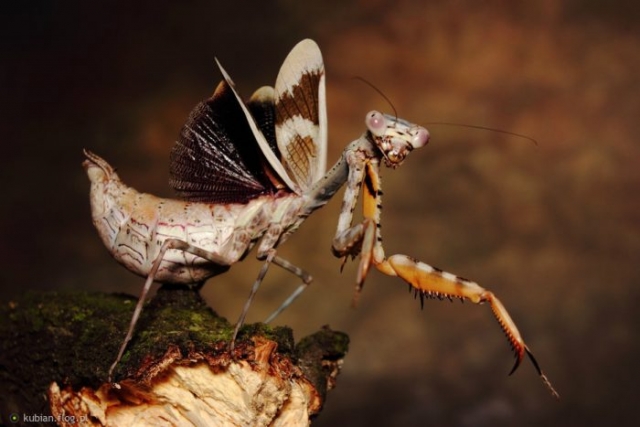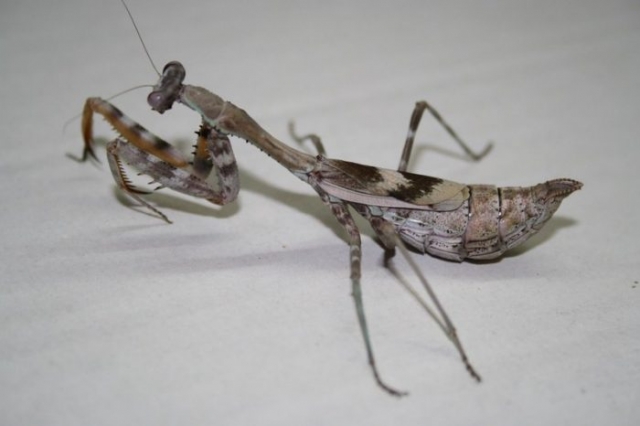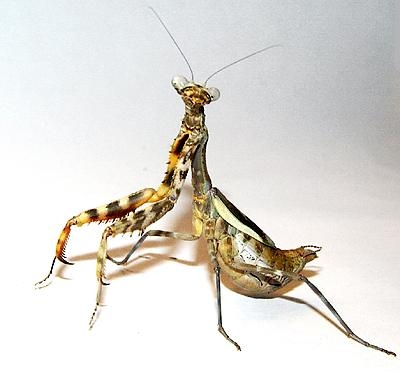Looks
The Parasphendale, a beautiful, mottled mantis, growing to very fat adults. Females only possess small bud wings, which where their name comes from.
One of the only species to posses only bud wings as adult, the Parasphendale is a wonderful looking species, with large pink eyes. Males will sprout fully-grown wings as adult, growing just over the end of their abdomen; females however will grow just small wing buds as adult. They only really come in a standard mottled colour, with brown, white, beige, and black covering their body and wings. When threatened, they will reveal splendid colours on the forearms, and hold them out beside their head in a way that will scare predators. Adults will raise their wings, to reveal red and orange colours, again to try and warn off predators. Females can reach up to 8cm in length, whilst males remain at around 4-5cm, and this is the easiest way of determining sex. It can also be done by using the usual method, 8 segments for the male, and 6 or 7 for the female.
Humidity and Temperature
Being a beginner species, the Parasphendale does not need any special conditions for its existence in captivity. They will live happily at room temperature (20-25c), and are able to live their whole lives at this temperature. However, if you wish to speed up growth, and increase the metabolism, then warmer temperatures of around 30c will be needed. High humidity is not required. Although, as young, spraying 2-3 times a week will help to overcome any problems with shedding of skin. As larger nymphs, when the wing buds start to swell, or any other signs of shedding approach, it will suffice to spray the mantis at that point. Again, this will help overcome any problems with skin shedding.
Housing and Enclosure
A fairly large enclosure will be needed for specimens of L6/7 upwards. Being a fairly long mantis, there must be enough height for successful skin shedding. Failure to do this can result in the mantis becoming entangled in its skin, and crippling the mantis. The Parasphendale are a species that like to hunt, so this can be satisfied again, by using a large enclosure. Put leaves and twigs in the tank to stimulate its natural habitat, but also to add interest to make it appealing to the eye. There must be a suitable surface for the mantis to grip on to, such as a mesh or net lid.
The Parasphendale is a very ferocious eater, and will consume nearly any food that will pass it. Because of this, you must limit the amount given to them as there have been cases where they have eaten to death. Standard live food such as crickets, locusts, wax worms and mealworms are good, however, the diet must be varied. Flies, wasps, bees, moths, and any other flying insect found outside will be much appreciated, and will be naturally gut-loaded. By offering a varied diet, you will notice that each specimen will be much larger, and will produce a much larger, more fertile ootheca. Do be careful when offering prey, making sure that it will not be to large for the mantis to catch, or consume. There have been many accounts of live food eating the mantis, so any food which ash not been consumed within a day or so, should be removed.
Ootheca can hatch up to 150 nymphs, all emerging at once. These are very easy to look after, and will live happily in a ventilated mesh enclosure. After 2-3 days, the nymphs will readily feed on fruit flies (Drosophila sp.) and pin head crickets. Cannibalism will set in at a very early stage, sometimes at L2. When this starts to happen, separate when you have a desired amount left for culture.
Summary
The Bug Winged Mantis is a lovely species, and not only an easy species to keep, but a very pretty one to. One of the easiest species to breed, and ootheca are very easy to hatch. Females have one of the most ferocious natures of any mantis, and can be very entertaining to watch feed, and hunt down prey.
Parasphendale (Budwing Mantis) Gallery
Please note the photos below have been collected from the web for reference, and each image links back to it’s original source. I don’t claim any copyright over these, and if you’ve got an image here that you’re not comfortable with and would like to be removed, then please get in touch.







Parasphendale Affinis (Budwing Mantis) discussion:
Feel free to post any comments on this species below: